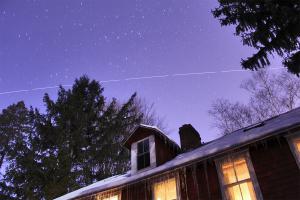
Public Stargazing
- Where:
- Frosty Drew Observatory
- When:
- Friday February 6, 2015 at 6:30 p.m.
- Cost:
- $1 Suggested Donation per Person
Tonight's forecast is calling for partly cloudy to mostly clear skies in the evening becoming clear overnight with a steady 5-9mph wind and a small possibility for the occasional 20mph gust. The 94% waning gibbous Moon will rise at 8:03 p.m. and will obscure most deep sky objects from our view. Overall, tonight's sky conditions should be acceptable for stargazing. Unfortunately, the wide open areas around the observatory have resulted in some pretty impressive snow drifts around the observatory and Frosty Drew campus. Add in the cold temps and icing, and winter conditions have made observatory access difficult. We will attempt an opening tonight, though at this point we are on hold, pending a status update from the observatory this evening.
Pending an on site inspection of conditions, we plan to open the Observatory and Sky Theatre at 6:30 p.m. tonight. In the Sky Theatre temperatures will be toasty warm and slide shows of astrophotos shot at Frosty Drew will be on display. The Observatory telescope will showcase Jupiter, which is at opposition today (closest point to Earth for the year), the waning gibbous Moon, and a handful of binary stars. Once Comet C/2014 Q2 Lovejoy moves into range of the telescope, we will offer up some excellent views of the comet's nucleus and coma (thin atmosphere that forms around the nucleus). With the bright Moon, we will plan to stay open until near 11:00 p.m. after which, the Moon will chase us out.
Overall, tonight will not be the night to make the long drive. The bright Moon coupled with the extreme winter conditions on site will make for limited stargazing. Those planning a visit should follow us on Twitter (@FrostyDrewOBSY) or Facebook and wait for a status update on access conditions before setting out. Otherwise, expect extreme winter conditions on site! Ice, snow, frigid temps, and limited parking are all factors involved in tonight's decision to geek out. Be sure to dress for it. Hey, it's New England and we get winter here!
-------------------------------------------------------------------------
Weekly Happenings
Scott MacNeill
This past week, the International Space Station (ISS) has started to pass over New England during the evening hours and will continue to do so until February 24th. Since the ISS orbits Earth once every 93 minutes at a 51.6° inclination to Earth's equator, evening visibility comes in periods throughout the year. For those who have not spotted the ISS passing over, it is quite an inspirational site to see. It is very bright, sometimes brighter than anything else in the sky aside from the Sun, Moon, and low flying aircraft. The ISS has maintained a constant human presence residing on it since November 2000 and is currently hosting the Expedition 42 crew. You can find out when the ISS is passing over New England on FrostyDrew.org or for your specific location using NASA's Spot The Station. Read more about the ISS, then make a point to step out in the evening for the next three weeks and catch stunning views of the ISS passing overhead and take a moment to think on all the awesome science that is taking place up there!
Jupiter, the largest planet in the Solar System and the fifth planet from the Sun will be at opposition on February 6, 2015, which is tonight! Opposition happens when an outer planet, in relation to Earth's position, reaches the point in its orbit when it is on the opposite side of Earth than the Sun. This is also consequently the point at which the planet is the closest to Earth, in most circumstances. During, and around the period of opposition, a planet is at its best viewing for all of us Earth-bound viewers. Additionally on the days around opposition, the planet will be visible from dusk to dawn with Meridian (the imaginary line that separates the Eastern and Western sky) intersection happening at midnight. Jupiter is an easy target for binoculars and small backyard telescopes. Binoculars will reveal the Galilean Moons periodically and a small telescope will reveal the equatorial bands in Jupiter's atmosphere. We will feature Jupiter for the remainder of winter and through the spring at Frosty Drew Observatory. Get out there these next few weeks and sneak a peak at Jupiter while the views rock!
-Scott


